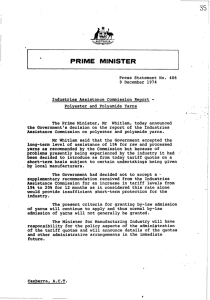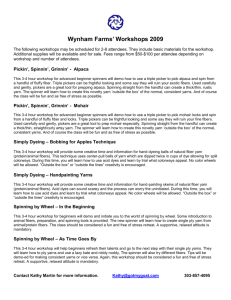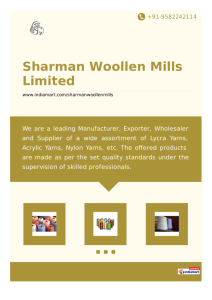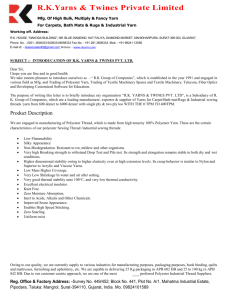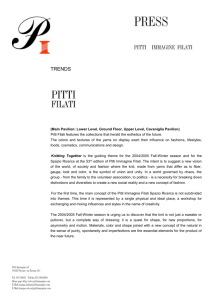n Introduction and number of faults Analysis of hairiness
advertisement
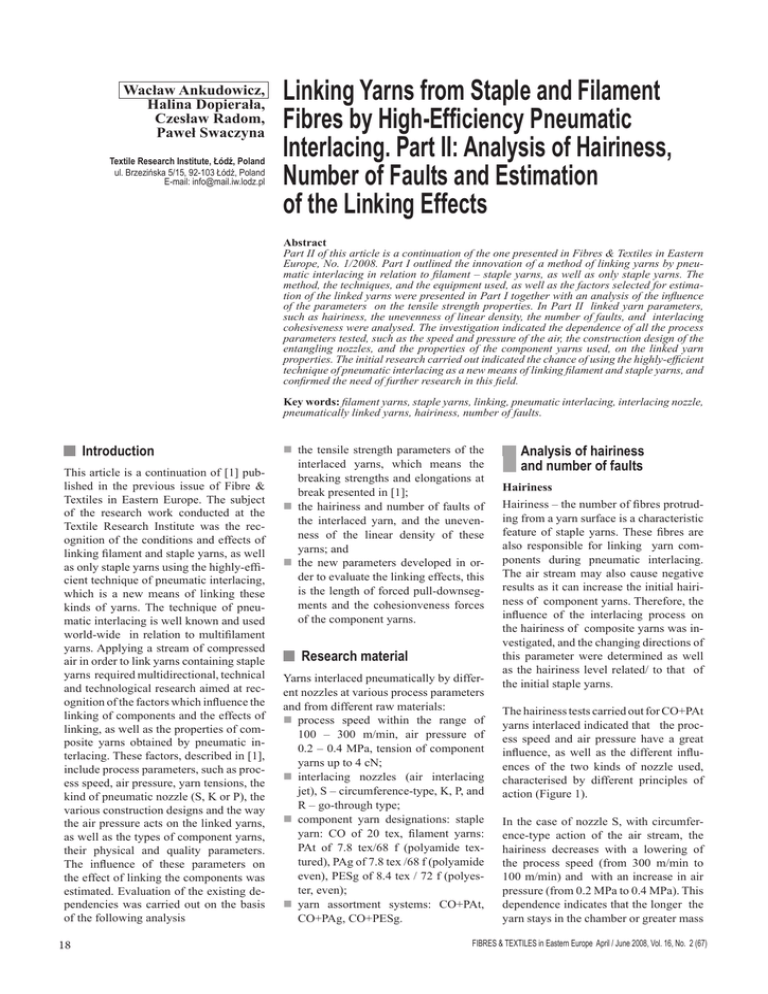
Wacław Ankudowicz, Halina Dopierała, Czesław Radom, Paweł Swaczyna Textile Research Institute, Łódź, Poland ul. Brzezińska 5/15, 92-103 Łódź, Poland E-mail: info@mail.iw.lodz.pl Linking Yarns from Staple and Filament Fibres by High-Efficiency Pneumatic Interlacing. Part II: Analysis of Hairiness, Number of Faults and Estimation of the Linking Effects Abstract Part II of this article is a continuation of the one presented in Fibres & Textiles in Eastern Europe, No. 1/2008. Part I outlined the innovation of a method of linking yarns by pneumatic interlacing in relation to filament – staple yarns, as well as only staple yarns. The method, the techniques, and the equipment used, as well as the factors selected for estimation of the linked yarns were presented in Part I together with an analysis of the influence of the parameters on the tensile strength properties. In Part II linked yarn parameters, such as hairiness, the unevenness of linear density, the number of faults, and interlacing cohesiveness were analysed. The investigation indicated the dependence of all the process parameters tested, such as the speed and pressure of the air, the construction design of the entangling nozzles, and the properties of the component yarns used, on the linked yarn properties. The initial research carried out indicated the chance of using the highly-efficient technique of pneumatic interlacing as a new means of linking filament and staple yarns, and confirmed the need of further research in this field. Key words: filament yarns, staple yarns, linking, pneumatic interlacing, interlacing nozzle, pneumatically linked yarns, hairiness, number of faults. n Introduction This article is a continuation of [1] published in the previous issue of Fibre & Textiles in Eastern Europe. The subject of the research work conducted at the Textile Research Institute was the recognition of the conditions and effects of linking filament and staple yarns, as well as only staple yarns using the highly-efficient technique of pneumatic interlacing, which is a new means of linking these kinds of yarns. The technique of pneumatic interlacing is well known and used world-wide in relation to multifilament yarns. Applying a stream of compressed air in order to link yarns containing staple yarns required multidirectional, technical and technological research aimed at recognition of the factors which influence the linking of components and the effects of linking, as well as the properties of composite yarns obtained by pneumatic interlacing. These factors, described in [1], include process parameters, such as process speed, air pressure, yarn tensions, the kind of pneumatic nozzle (S, K or P), the various construction designs and the way the air pressure acts on the linked yarns, as well as the types of component yarns, their physical and quality parameters. The influence of these parameters on the effect of linking the components was estimated. Evaluation of the existing dependencies was carried out on the basis of the following analysis 18 n the tensile strength parameters of the interlaced yarns, which means the breaking strengths and elongations at break presented in [1]; n the hairiness and number of faults of the interlaced yarn, and the unevenness of the linear density of these yarns; and n the new parameters developed in order to evaluate the linking effects, this is the length of forced pull-downsegments and the cohesionveness forces of the component yarns. n Research material Yarns interlaced pneumatically by different nozzles at various process parameters and from different raw materials: n process speed within the range of 100 – 300 m/min, air pressure of 0.2 – 0.4 MPa, tension of component yarns up to 4 cN; n interlacing nozzles (air interlacing jet), S – circumference-type, K, P, and R – go-through type; n component yarn designations: staple yarn: CO of 20 tex, filament yarns: PAt of 7.8 tex/68 f (polyamide textured), PAg of 7.8 tex /68 f (polyamide even), PESg of 8.4 tex / 72 f (polyester, even); n yarn assortment systems: CO+PAt, CO+PAg, CO+PESg. n Analysis of hairiness and number of faults Hairiness Hairiness – the number of fibres protruding from a yarn surface is a characteristic feature of staple yarns. These fibres are also responsible for linking yarn components during pneumatic interlacing. The air stream may also cause negative results as it can increase the initial hairiness of component yarns. Therefore, the influence of the interlacing process on the hairiness of composite yarns was investigated, and the changing directions of this parameter were determined as well as the hairiness level related/ to that of the initial staple yarns. The hairiness tests carried out for CO+PAt yarns interlaced indicated that the process speed and air pressure have a great influence, as well as the different influences of the two kinds of nozzle used, characterised by different principles of action (Figure 1). In the case of nozzle S, with circumference-type action of the air stream, the hairiness decreases with a lowering of the process speed (from 300 m/min to 100 m/min) and with an increase in air pressure (from 0.2 MPa to 0.4 MPa). This dependence indicates that the longer the yarn stays in the chamber or greater mass FIBRES & TEXTILES in Eastern Europe April / June 2008, Vol. 16, No. 2 (67) Figure 1. Hairiness of yarns: a) staple yarn CO, b) pneumatically linked CO+PAt in dependence on air pressure, c) CO+PAt in dependence on the linking process speed. of air acting on the yarn, the more intensive the wrapping of the staple yarn around the filament component is, which leads to a decrease in hairiness. In the majority of tests, yarns linked by this nozzle were characterised by hairiness lower or at a similar level of hairiness than that of the staple component yarn. In the case of nozzle K – of the gothrough action, a dependency opposite to that of nozzle S occurs, this is a decrease in hairiness as a result of the process speed decreasing, or a decline in air pressure. For yarns linked by this nozzle, the hairiness is, in the majority of cases, higher than the hairiness of component yarn. It is possible to obtain yarn hairiness at a level similar to that of initial staple yarn by appropriate selection of the process speed, air pressure, tensions of component yarns, and by use of interlacing nozzles. Number of faults An analysis of the number of faults indicated not only a significant dependence on the type of pneumatic nozzle and process parameters (speed, pressure, and yarn tensions), but also on the number of faults of the cotton yarn used for linking. The influence of nozzles, the process speed, and air pressure on the number of faults of the interlaced yarns CO+PAt is illustrated in Figures 2 and 3. The number of faults in interlaced yarns is significantly lower in comparison with those occurring in cotton yarn, which is caused by the higher measurement vol- Figure 2. Influence of the process speed and kind of nozzle on the number of faults of the yarn CO+PAt pneumatically interlaced FIBRES & TEXTILES in Eastern Europe April / June 2008, Vol. 16, No. 2 (67) ume of new yarn obtained and the equalising effect of filament yarn. The number of neps in linked yarns was the subject of a detailed analysis. The yarns interlaced in nozzle S, of the circumference-type action of the air stream, are characterised by a generally low number of neps, which is lower than that of cotton yarn. The yarns interlaced in nozzles K, P and R, with the go-through action of air, are characterised by a considerably greater number of neps. In the case of these nozzles, a significant increase in the number of neps takes place with an increase in air pressure (an increase in the air stream speed) or a lowering of the process speed (the yarn stays longer in the nozzle chamber). Among nozzles P, K, and R (with differ- Figure 3. Influence of air pressure and kind of nozzle on the number of faults of the yarn CO+PAt pneumatically interlaced 19 of yarn from nozzle K, we obtained short lengths of the forced pull-down segments (on average from 1.5 cm to 5 cm), which indicates the intensive linking and higher durability of the composite yarn, as well as a higher frequency of the connections in comparison with yarns linked by nozzle S. This factor appeared useful for the whole range of investigation of all the process parameters (speed, pressure, tensions) of different nozzles and raw materials. Figure 4. Influence of the process speed and the kind of nozzles on the length of the forced pull-down segments. Figure 5. Influence of the air pressure and the kind of nozzles on the length of the forced pull-down segments. ent characteristics of air stream action) the most advantageous results concerning the number of neps were obtained by using nozzle P, whereas considerably better results could have been obtained by using nozzle S of the circumferencetype. While measuring the number of faults with use of a Uster apparatus, the unevenness of the linear density was also tested. We observed that the yarns investigated with a linear density of about 28 tex, which included cotton yarn, were characterised by a low level of linear density unevenness within the range of 10% -12%, compared to the initial staple yarns with CV of 13% -15%. laced filament – staple yarns on the basis of measuring the length of the filament yarn segments obtained as a result of forcibly breaking and pulling-down staple yarn along the filament yarn by hand. The method of determining this parameter is described in [1], whereas the measurement results are presented in Figures 4 and 5. n Evaluation of yarn linking effects on the basis of new factors Forced pull-down segments This new parameter allows the evaluation of the effect of pneumatically inter- 20 These results indicate the essential difference in the effects of linking yarns interlaced by nozzle S and by nozzles K and P, which was illustrated by the long forced pull-down segments of the yarn linked by nozzle S (average within the range of 25 cm - 75 cm). The length of the forced pull-down segments indicates the weak linking of the staple and filament yarn segments. The weaker the connection, the higher the speed of yarn transport through the nozzle or the lower the air pressure is. What is more, the range of changes is very high, which indicates great unevenness of linking. In the case Force of cohesiveness The force of cohesiveness calculated by measuring the force needed to divide the component yarns, indicates the performance of the components interlaced in a composite yarn. Initial investigations and the analysis of the force on cohesiveness proved that the pneumatic nozzle, the raw material used and the process parameters have a significant influence on the linking effect of both components. Higher values indicate a higher performance and durability of the linked components. During our investigations we were able to confirm that the method elaborated is fully acceptable for testing composite yarns linked by the circumference-type nozzle S and for homogeneous yarns, for which a possibility existed of initially dividing the components into a length necessary to begin the measurements. In the case of composite yarns, linked by gothrough type nozzles K, P and R, which are characterised by a great frequency of strong connections, it was hard, and in the majority of variants impossible to divide the component yarns into a length necessary to begin the measurements. In places of strong interlaced yarns, a break in the staple component occurred. A run of dividing forces for yarns linked by the circumference-type nozzle S and gothrough type P is presented in Figure 6. The characteristic of the dividing forces (cohesiveness forces) for the circumference-type nozzle S is presented in Figure 7. An increase in the cohesiveness force with an increase in air pressure (an increase in the air stream speed and its mass) could be observed for yarns linked by nozzle S. An opposite dependence can be observed with an increase in the process speed (at constant air pressure), which is connected with the shorter time of interaction of the air stream on the yarn. The influence of the components of (this is the stample and the filament yarn) is visible on the level of the cohesiveness forces. While applying various filament yarns, we observed that by the FIBRES & TEXTILES in Eastern Europe April / June 2008, Vol. 16, No. 2 (67) n Summary Figure 6. Exemplary curves of cohesiveness force of CO+PESg yarns, a) linked by P type nozzle, b) linked by S type nozzle. Figure 7. Forces of cohessiveness of yarns interlaced by circumference – type nozzle S as a function of process speed (rate), air pressure and components type. highest cohesiveness is characterised the yarns interlaced with the component yarn PESg, which is lower than those linked with the yarn PAg, and by the lowest composite yarns containing PAt yarn These dependencies confirm the influence of structural and surface features of filament yarns on the performance of linking with staple yarn. While using the staple yarn CO – manufactured by a ring-spinning frame and CO/B –from an open-ring spinning system, a lower level of cohesiveness forces can be observed for yarns interlaced with the use of the CO/B component. This dependence is the result of significantly lower hairiness of the yarn CO/B (a lower number of fibres which are responsible for linking the component yarns.) For composite yarns linked by the gothrough type nozzles (P and K), the maximum dividing forces achieved a level several times higher than those of yarns obtained from the circumference-type nozzle. The average values of these forces achieved a level near to half the value of the breaking forces at the first peak, which were determined by tests assessing the tensile strength properties. FIBRES & TEXTILES in Eastern Europe April / June 2008, Vol. 16, No. 2 (67) The research work carried out represents recognisable material which indicates the possibility of using the highly efficient technique of pneumatic interlacing as a new direction in the technology of manufacturing filament – staple yarns. The action of a stream of compressed air on yarns containing, as components, yarns from staple fibres causes different results related to their mechanical and surface features, as well as in the mutual connection of the components. A broad knowledge was attained concerning the structural and quality features of the new composite yarns obtained by the interlacing technique and the directions of their changes caused by the different ways and the intensity of the compressed air stream action on the yarns being interlaced (different construction designs of the nozzles), the differentiated parameters of the technological process, and various features of the component yarns used. A complex analysis of the filament – staple yarn parameters (also including the process parameters and the types of nozzles analysed) allows to present the following observations: n Owing to the tests conducted, we indicated that the circumference-type nozzle positively influences theyarn surface parameters, which means the number of faults and hairiness, whereas go-through type nozzles allow to obtain better results concerning the performance of component linking, cohesiveness and breaking strength resistance. n Yarns obtained by go-through type nozzles in relation to yarns obtained by the circumference-type nozzle are characterised by generally much greater tensile strength properties, lower elongations at break and a significantly higher performance of linking (high cohesiveness and very short forced pull-down segments). The negative action of the go-through type nozzles can be observed in the number of faults and in hairiness. n The design of nozzles and the process parameters have an essential influence on all factors of the yarns interlaced. Their selection in order to link yarns containing a staple component is decisive for the solution of this problem. n A significant influence of the structural, mechanical and surface prop- 21 erties of the component yarns on the final effect of linking and the features of the interlaced yarns could also be observed. The results of the recognition investigations were the inspiration for the continuation of research work into the selection and constructional designs of nozzles dedicated to interlacing yarns with a content of staple yarn, and of homogeneous staple yarn, and to the evaluation of the behaviour of the new composite yarns obtained in further processing The results of these investigations will be the subject of an independent publication. Acknowledgment References 1. Ankudowicz W., Dopierała H.: „Pneumatic interlacing in manufacturing filament – staple yarns”, Przegląd włókienniczy nr 1, 2005. p. 37-41. 2. E. Schwarz, L. Lacher, Heberlein: „Air Covering: a process with great potential”. IFJ Oktober 2001. p. 62-66. 3. http://www.heberlein.com 4. http://www.temco.com 5. http://www.ssm-airtex.com 6. Scherpt H-D., Zenses Marc A.: „Advanced Air Jets to Meet Higher Performance Yarn Reguirements. IFJ, February 2004, pp. 60 – 61. 7. PN-EN ISO 2062: 1997 „Tekstylia. Nitki w nawojach. Wyznaczanie siły zrywającej i wydłużenia przy zerwaniu odcinków nitki”. 8. Królikowska H., Ankudowicz W., Dopierała H.: „Some aspects of evaluation pneumatic interlaced filament – staple yarns”, Przegląd włókienniczy nr 12, 2005r. 9. P N-91/P-04685 „Tekstylia. Przędza, włóczka. Wyznaczanie włochatości metodą fotoelektryczną”. 10. P N - 7 6 / P - 0 4 8 0 4 „ M e t o d y b a d a ń wyrobów włókienniczych. Przędza i półprodukty przędzenia. Wyznaczanie nierównomierności masy liniowej metodą elektropojemnościową”. 11. Ankudowicz W., Dopierała H., Radom C., Swaczyna P.: Linking Yarns from Staple and Filament Fibres by High-Efficiency Pneumatic Entanglement. Part I: Factors Influencing the Linking Effect and the Properties of Entangled Yarns. Analysis of Tensile Strength Parameters, Fibres & Textiles in Eastern Europe vol.16. Nr.1.(66) 2008, pp. 37-43. 22 EL-TEX 2008 Electrostatic and Electromagnetic Fields New Materials and Technologies will be held on 26-27 November 2008 in Łódź, Poland. This research work was financially sponsored by the Ministry of Science and Higher Education over the years 2003 2004 and 2005 0 2998 Received 14.06.2007 The 8th International Symposium The Symposium is organised by the Textile Research Institute (IW) in Łódź, the Institute of Telecommunication, Teleinformatics and Acoustics (ITT&A) of the Technical University of Wrocław, and the Polish Committee of Electrostatics (SEP), Warsaw. El-Tex Symposium has been organised by the Textile Research Institute since 1994. On the 1st of July 2007 the Textile Research Institute was enlarged by the inclusion of the following formerly independent institutions: n Institute of Textile Architecture (Instytut Architektury Tekstyliów – IAT) n Institute of Textile Materials Engineering (Instytut Inżynierii Materiałów Włókienniczych) n TRICOTEXTIL Institute of Knitting Techniques and Technologies (Instytut Technik i Technologii Dziewiarskich Tricotextil) The main aim of El-Tex 2008 is the survey and promotion of scientific, technological and applicational developments and the exchange of experiences between experts representing different scientific disciplines. The program will cover a selection of issues in the scope of: n the effects of electromagnetic fields (EMF) onto human health, n eliminating or restricting the hazards caused by the occurrence of static electricity, n environmental aspects of EMF, n production methods and application of textile shielding materials, n electrostatic evaluation of textile fabrics, n the metrology of electrostatic and electromagnetic fields. Deadlines: n abstract submission in English (2 pages A4) n paper/poster acceptance n manuscripts ready for printing n submission of presentations in electronic form n payment of registration fee 25.04.2008 31.05.2008 30.06.2008 30.06.2008 30.09.2008 Registration fee: authors 200 EURO, other participants 250 EURO The fee covers: participation in sessions, CD with abstracts and presentations, boarding, and social event. Hotel costs are not included. Recommended accommodation and Symposium venue: Hotel AMBASADOR, address: ul. Kosynierów Gdyńskich 8, 93-320 Łódź, Poland tel.+4842 646 49 04 Information: Textile Research Institute (IW), Brzezińska 5/15, 92-103 Łódź, Poland, fax: +4842 6792638 Contact persons: Katarzyna Grzywacz tel. (+4842) 6163 195, e-mail: grzywacz@iw.lodz.pl Joanna Koprowska tel (+4842) 6163 116, e-mail: koprowska@iw.lodz.pl Reviewed 23.01.2008 FIBRES & TEXTILES in Eastern Europe April / June 2008, Vol. 16, No. 2 (67)
